聚多巴胺亲水改性 -锂硫电池
两性离子表面改性阴离子交换膜及其抗污染性能

两性离子表面改性阴离子交换膜及其抗污染性能谭瑞卿;阮慧敏;廖俊斌;沈江南【摘要】受贻贝结构的启发,采用聚多巴胺(PDA)涂层沉积在季胺化溴化聚苯醚(QPPO)阴离子交换膜上(Q-PDA),然后通过Michael加成反应将含叔胺官能团的活性分子N,N-二甲基乙二胺(DMDA)接枝到含有伯胺基团的PDA活性层上(Q-P2D).DMDA功能化后的阴离子交换膜进一步与1,3-丙烷磺酸内酯反应,制备了两性离子表面改性的抗污染阴离子交换膜(Q-P2DZ).抗污染实验中,QPPO膜出现了严重的污染现象.由于PDA的亲水性阻碍了有机污染物SDBS在膜表面的粘附和团聚,Q-PDA表现出改善的抗污染性能,其"转变时间"约为109 min.由于PDA表面水合性和带负电荷或电中性的改性层与SDBS之间具有静电排斥力,此二者的双重作用,使SDBS隔离于膜表面而显著增强膜的抗污染能力.【期刊名称】《浙江化工》【年(卷),期】2018(049)007【总页数】7页(P34-40)【关键词】阴离子交换膜;两性离子;聚多巴胺;抗污染;电渗析脱盐【作者】谭瑞卿;阮慧敏;廖俊斌;沈江南【作者单位】浙江工业大学膜分离与水科学技术中心, 浙江杭州 310014;浙江工业大学膜分离与水科学技术中心, 浙江杭州 310014;浙江工业大学膜分离与水科学技术中心, 浙江杭州 310014;浙江工业大学膜分离与水科学技术中心, 浙江杭州310014【正文语种】中文0 前言电渗析(ED)是一种基于膜组件的相对成熟的利用离子交换膜的选择性从料液中分离特征离子的分离过程。
此项技术已被广泛用于废水处理,海水淡化[1]。
然而,在工业应用中,特别是对于复杂的水体系,污染物容易发生结垢,在离子交换膜表面上沉积,导致膜性能的恶化。
在膜污染问题中,以阴离子交换膜(AEM)的有机污染问题最为严重,由于AEM含有正电荷基团,而处理的料液中含有大量的带有负电荷的有机污染物,如:表面活性剂、腐殖酸、蛋白质,因此在电渗析处理过程中,正负电荷相互作用极易发生不可逆的有机污染。
多功能聚多巴胺材料的合成、表面修饰及其应用

多功能聚多巴胺材料的合成、表面修饰及其应用1. 引言多功能聚多巴胺材料在当今材料科学领域备受关注。
作为一种具有多种优秀性能的材料,多功能聚多巴胺材料的合成、表面修饰及其应用,已经在许多领域展现出巨大的潜力。
在本文中,我们将深入探讨多功能聚多巴胺材料的合成、表面修饰及其应用,并就其在材料科学领域中的潜在应用进行深入的讨论。
2. 多功能聚多巴胺材料的合成2.1 聚多巴胺的结构与性质让我们先来了解一下聚多巴胺的结构与性质。
聚多巴胺是一种具有氨基酸结构的生物聚合物,其分子中含有许多亲亲化学团,使得其具有优异的黏附性和亲水性。
这种特殊的结构与性质为多功能聚多巴胺材料的合成奠定了基础。
2.2 多功能聚多巴胺材料的合成方法目前,研究人员已经开发出多种不同的方法来合成多功能聚多巴胺材料。
化学聚合法、自催化聚合法、生物合成法等。
不同的合成方法可以产生具有不同结构和性质的多功能聚多巴胺材料,为其后续表面修饰和应用提供了丰富的选择。
3. 多功能聚多巴胺材料的表面修饰3.1 表面修饰的意义和必要性多功能聚多巴胺材料的表面修饰是为了赋予其更多的功能和应用特性。
通过表面修饰,可以使多功能聚多巴胺材料具有更好的生物相容性、催化性能、光学性能等,从而扩大其在不同领域的应用范围。
3.2 表面修饰的方法与应用目前,研究人员已经开发出各种不同的方法来对多功能聚多巴胺材料进行表面修饰。
化学修饰、生物修饰、生长修饰等。
通过不同的表面修饰方法,可以在多功能聚多巴胺材料上引入各种功能基团,从而使其具有不同的应用特性。
4. 多功能聚多巴胺材料的应用4.1 生物医学领域中的应用多功能聚多巴胺材料在生物医学领域中具有广泛的应用前景。
用于药物缓释、组织工程、生物传感等方面。
其优异的生物相容性和表面修饰的灵活性,使得多功能聚多巴胺材料成为了生物医学领域中的研究热点。
4.2 环境保护领域中的应用另外,多功能聚多巴胺材料还具有巨大的潜力用于环境保护领域。
基于水基无氟方法制备单向导水织物研究
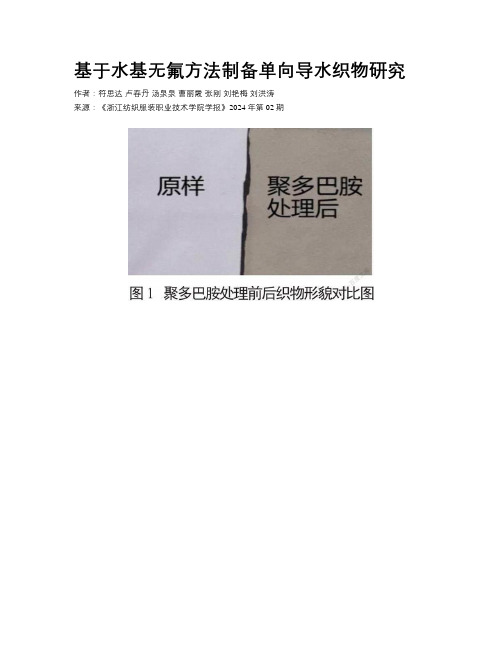
基于水基无氟方法制备单向导水织物研究作者:符思达卢春丹汤泉泉曹丽霞张刚刘艳梅刘洪涛来源:《浙江纺织服装职业技术学院学报》2024年第02期摘要:單向导水织物在吸湿排汗服饰、土壤稳定、水资源管理、农业、环境保护等领域中广泛应用,但是目前制备单向导水织物往往使用有机溶剂和含氟化学品,对环境、人体健康等造成危害。
本文基于水基无氟方法制备单向导水织物,先对织物进行聚多巴胺涂层处理,然后将十六烷基三甲氧基硅烷水解产物通过静电纺丝的方法喷涂在聚多巴胺修饰的织物单面,形成防水的单面。
由于没有喷涂的一面保持超亲水的特性,织物就形成了从超亲水到超疏水的梯度结构,从而具有单向导水的性质。
此制备方法安全环保,具有广泛的应用前景。
关键词:水基;无氟;单向导水;织物中图分类号:TS190.8 文献标识码:A 文章编号:1674-2346(2024)02-0001-04Study on the Preparation of Directional Water Transport Fabrics Basedon Waterborne Fluoride-Free MethodFU Sida1,2,3 LU Chundan2 TANG Quanquan2 CAO Lixia2 ZHANG Gang LIU Yanmei2 LIU Hongtao1(1.School of Chemical Engineering & Technology,China University of Mining and Technology,Xuzhou, Jiangsu 221000,China;2.Zhejiang Meixinda Textile Printing and Dyeing Technology Co.,Ltd.,Huzhou, Zhejiang 313000,China;3.China-Australia Institute for Advanced Materials and Manufacturing,Jiaxing University,Jiaxing,Zhejiang 314000,China)Abstract: Directional water transport fabrics have found extensive applications in various fields such as moisture-wicking clothing,soil stabilization,water resource management,agriculture,environmental protection,etc. However,the current manufacturing process of directional water transport fabrics often involves the use of organic solvents and fluorinated chemicals,posing hazards to the environment and human health.This paper introduces a waterborne,fluorine-free approach for producing directional water transport fabrics.The fabric is initially treatedwith a polydopamine coating,followed by the application of hexadecyltrimethoxysilane hydrolysis products using electrospinning on one side of the polydopamine-modified fabric,creating a water-resistant surface.Since the untreated side retains its superhydrophilic properties,the fabric forms a gradient structure ranging from superhydrophilic to superhydrophobic,thereby exhibiting directional water transport property.The preparation method is safe and environmentally friendly,and has wide application prospects.Key words: waterborne;fluoride-free;directional water transport;fabric单向导水织物是一种新型材料,它在吸湿排汗服装、现代工程、建筑、农业和环境保护等各领域都发挥着重要作用[1-3]。
多巴胺氧化聚合膜表面改性技术研究进展

第41卷第1期2021年(月膜科学与技术MEMBRANE SCIENCE AND TECHNOLOGYVol41No1Feb&2021多巴胺氧化聚合膜表面改性技术研究进展田欣欣,王暄$,彭维,吕晓龙$,于越,袁晓彤(分离膜与膜过程国家重点实验室,天津工业大学环境科学与工程学院,天津300387)摘要:近年来,以多巴胺(Dopamine,DOPA)为代表的仿生贻贝物质因其在膜表面改性过程中的简易性、普适性及良好的后功能化潜力而在复合膜制备领域备受关注.虽然DOPA在有氧的弱碱性水溶液中能够自聚合生成聚多巴胺(Polydopamine,PDA),但存在自聚合缓慢等问题,加入氧化剂可显著提高自聚合速率.本文重点综述了过硫酸铁、高碘酸钠等氧化剂对于DOPA自聚合过程以及复合膜PDA聚合层稳定性、耐污染性能等的影响,并简要介绍了DOPA氧化自聚合膜表面改性技术在膜生物膜反应器(Membrane biofilm reactor,MBfR)领域中的研究现状,通过该技术有望获得具有良好的氧传质性能、生物亲和性以及耐污染性能的复合膜,在MBfR领域具有良好的应用前景.关键词:多巴胺自聚合;膜表面改性;氧化剂;膜生物膜反应器中图分类号:TQ028.8文献标志码:A文章编号:10078924(2021)01015208doi:10.16159/ki.issnl007-8924.202101020膜材料是膜技术发展的关键,但在实际应用中很多高分子分离膜因其较强的疏水性、较差的耐污染性能等限制了其在污水处理、油水分离、生物医药等领域的应用,研究者们采用表面涂覆、表面接枝、界面聚合、自聚合等表面改性方法研究开发性能优异的复合膜•近年来,以左旋多巴(8-3,4dihydroxyphenylalanine,L-DOPA)、多巴胺(Dopamine,DOPA)为代表的仿生贻贝物质因其在表面改性过程中的简易性、普适性及良好的后功能化潜力而在复合膜制备领域备受关注,被广泛用于与能源、环境和生物等诸多领域相关的材料表面改性和功能化研究中'1—2(. DOPA是L-DOPA的衍生物之一,其分子内部含有大量的邻苯二酚轻基官能团和赖氨酸的氨基基团3,可在氧气存在的弱碱条件下(pH通常为&5)氧化自聚合形成聚多巴胺(Polydopamine,PDA),PDA表面丰富的轻基和氨基官能团能够增强膜表面亲水性:4—6(.已有研究者详尽综述了DOPA等贻贝仿生物质自聚合机理、基于贻贝仿生化学的分离功能材料制备与结构调控的研究现状等口7•PDA复合材料的性能依赖于DOPA的自聚合、PDA的沉积及聚合层的稳定性但DOPA自聚合速度缓慢,反应时间通常长达数小时至数天3,这限制了DOPA自聚合表面改性技术的应用范围.研究者们尝试采用添加氧化剂、紫外辐照、电化学驱动等方法加速DOPA自聚合反应速度,提高DOPA 聚合层的稳定性28—0,其中氧化聚合法因其简便、高效得到了研究者们广泛的关注•论文综述了多种不同氧化剂条件下DOPA自聚合表面改性技术的研究现状,并展望了DOPA氧化聚合表面改性技术在膜曝气生物技术领域的应用前景,以期为收稿日期:202002-18;修改稿收到日期:2020-10-29基金项目:国家自然科学基金(51408415)第一作者简介:田欣欣(1996-,女,河北省邢台市人,硕士生,从事膜表面改性及MBfR应用研究,E-mail:txx9652@163.com.$通讯作者,E-mail:xuanwang@;139****6131"引用本文:田欣欣,王暄,彭维,等•多巴胺氧化聚合膜表面改性技术研究进展[J1膜科学与技术,021,1(1):152—159&Citation:Tian X X,Wang X,Peng W,tal.Research progress on membrane surface modification technology of dopamine oxidationpolymerization'J(&MembraneScienceandTechnology(Chinese)202141(1):152—159&第1期田欣欣等:多巴胺氧化聚合膜表面改性技术研究进展・153・DOPA等贻贝仿生物质氧化聚合膜表面改性技术的进一步发展及应用提供参考.1不同氧化剂对DOPA自聚合的影响受到贻贝黏附蛋白的启发,Lee和Messersmith 等3发现,在碱性条件下DOPA在氧气存在下能自发聚合Kim等'1(提到,在没有氧气存在的情况下"在任何pH条件下DOPA都不会发生聚合.然而Messersmith最初提出的传统方法有3个缺点,阻碍了DOPA自聚合改性技术在许多领域的应用.首先,许多碱性敏感材料,如聚酯、酚醛树脂、蛋白质等不适合在碱性溶液中进行DOPA改性;其次,PDA 涂层的形成是一个慢速过程;而且PDA涂层在酸性、碱性等介质以及极性有机溶剂中稳定性塞12-⑷.为了克服这些缺点,研究者们提出了许多方法,其中各种氧化剂如过硫酸R、高碘酸钠、高猛酸钾等疋-16不仅可以加速DOPA在碱性条件下的氧化自聚合过程,提高PDA的沉积速率和稳定性"还可催化DOPA在酸性或者中性条件下自聚合.氧化诱导法扩大了DOPA氧化自聚合表面改性技术HO OH C的应用范围,但一些化学氧化剂不可避免地会残留性中2006年,Li等研究了DOPA的氧化聚合过程,提出了DOPA氧化平衡机理:DOPA中的V基被氧化为摄基生成多巴胺醞(dopaminequinone)$进行加成反应分子内环化生成5,6-二V基卩引嗥咻(leucodopaminechrome),氧化重器乍形成了5,6-二V基卩引嗥(5,6-dihydroxyindole),从而聚合形成PDA(如图1)'8(.程毅丽等利用DOPA的氧化自聚反应对PTFE中空纤维膜进行亲水化改性,改性后膜接触角由110°降到80K抗污染能力得到提高,表1为DOPA改性8h后的牛血清白蛋白(Bovine serum albumin,BSA)污染实验结果,冲洗后改性膜的通量有90%以上的恢复率.1.1酶催化氧化DOPA聚合近年来,酶催化合成高效环保型聚合物已成为一个重要的研究热点.Tan等'0(首次报道漆酶可以在玻璃碳电极上诱导DOPA聚合,漆酶存在时DOPA的氧化聚合速度显著增加,这在生物传感器和生物燃料电池中具有重要意义•但是漆酶对PDA 结构、PDA层厚度、粗糙度、稳定性等性能的影响仍PH HO OH图1DOPA氧化自聚合机制示意图'8(Fig1Schematicdiagramofoxidativeself-polymerizationmechanismofdopamine '18(・154・膜科学与技术第41卷表1 改性前后聚四氟乙烯膜的BSA 污染实验结果Table1L BSA fouling results of the original and modified membranes'9项目水通量/ (L ・ m —2・h —1)BSA 渗透通量/(L ・m —2・h —1 )的水通量/(L ・m —2・h —1)BSA 通量衰减率/%通量 恢复率/%BSA 的截 留率/%PTFE 904880478990PTFE-PDA13290124329487然未知•因此,为了更好地了解漆酶催化DOPA 聚合的机理还需进一步研究,这将有助于今后PDA 的可控制备.1, 2高锚酸钾氧化DOPA 聚合Tahroudi 等'1(以玻璃片作为载体探究高猛酸 钾对DOPA 聚合的影响,研究结果表明,加入氧化剂后PDA 聚合速度高、聚合层厚度大且不会改变PDA 固有特性.在高猛酸钾与DOPA 摩尔比率为表2Table 2 Stability percentage after exposing samples to different treatments '1^样品经不同处理后的稳定性百分比[21]稳定性实验类别稳定性百分比/%加入高猛酸钾后的PDA 涂层无高猛酸钾加入的PDA 涂层pH = 8,t =10 min (化学稳定性)306pH = 4,t =10 min (化学稳定性)878t =10 min,T =70 C (热稳定性)2819t =10 min,超声波(机械稳定性)4161.3硫酸铜氧化DOPA 聚合Riley 等'2(提到另一种DOPA 的聚合机理——自由基反应,认为中间产物半醞自由基通过偶联形成交联键从而实现DOPA 的聚合DOPA 的氧化聚合机理较为复杂,CuSO 4/ H 2O2体系含有OH •等自由基'(并且DOPA 转化为醞式结构的氧化还原电位为0. 12 V,Cf 十的氧化还原电位为0. 34 V 足 以氧化DOPA '3(,提高了 DOPA 反应速度和聚合 度Zhaig 等⑵利用DOPA 对聚丙烯微孔膜进行表0.4的最佳条件下,涂覆速度可达750 nm/h ,是选用高碘酸钠作为氧化剂(高碘酸钠与DOPA 摩尔比率为2的最佳比例)时PDA 沉积速率的25倍.表2 为氧化剂高猛酸钾添加对PDA 稳定性的影响,其中稳定性百分比是根据实验前后PDA 的厚度计算 得出,可以看出高猛酸钾的加入加快了 DOPA 的氧化聚合反应,提高了 PDA 的沉积速率和PDA 涂层 在膜表面的稳定性.面改性,选用含有大量活性氧自由基的CuSO 4/ H 2O 2 体系通过改变CuSO 4与H 2O 2的比例来调节DOPA的聚合速率,在 5 mmol/L CuSO 4 和 19. 6 mmol/LH 2O2条件下得到的PDA 聚合层具有足够的厚度"较高的均匀性和稳定性,改性10 min 后聚丙烯微孔 膜表面接触角由126。
聚多巴胺 二氧化锰 p 型半导体
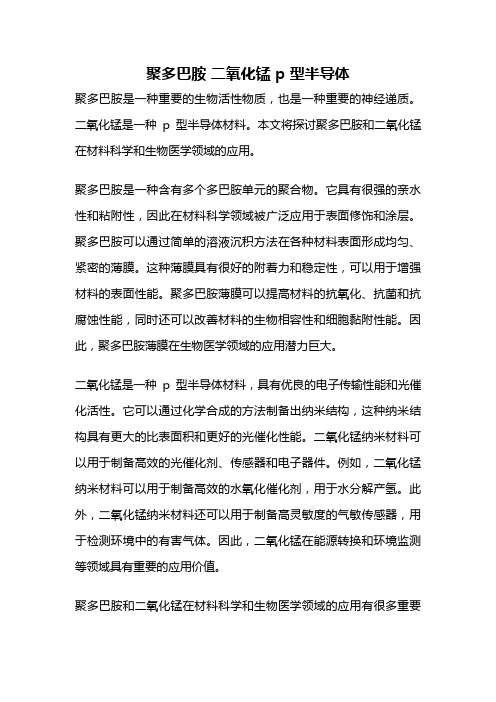
聚多巴胺二氧化锰 p 型半导体聚多巴胺是一种重要的生物活性物质,也是一种重要的神经递质。
二氧化锰是一种p型半导体材料。
本文将探讨聚多巴胺和二氧化锰在材料科学和生物医学领域的应用。
聚多巴胺是一种含有多个多巴胺单元的聚合物。
它具有很强的亲水性和粘附性,因此在材料科学领域被广泛应用于表面修饰和涂层。
聚多巴胺可以通过简单的溶液沉积方法在各种材料表面形成均匀、紧密的薄膜。
这种薄膜具有很好的附着力和稳定性,可以用于增强材料的表面性能。
聚多巴胺薄膜可以提高材料的抗氧化、抗菌和抗腐蚀性能,同时还可以改善材料的生物相容性和细胞黏附性能。
因此,聚多巴胺薄膜在生物医学领域的应用潜力巨大。
二氧化锰是一种p型半导体材料,具有优良的电子传输性能和光催化活性。
它可以通过化学合成的方法制备出纳米结构,这种纳米结构具有更大的比表面积和更好的光催化性能。
二氧化锰纳米材料可以用于制备高效的光催化剂、传感器和电子器件。
例如,二氧化锰纳米材料可以用于制备高效的水氧化催化剂,用于水分解产氢。
此外,二氧化锰纳米材料还可以用于制备高灵敏度的气敏传感器,用于检测环境中的有害气体。
因此,二氧化锰在能源转换和环境监测等领域具有重要的应用价值。
聚多巴胺和二氧化锰在材料科学和生物医学领域的应用有很多重要的研究成果。
例如,研究人员通过将聚多巴胺薄膜和二氧化锰纳米材料复合制备出了一种新型的电极材料,用于制备柔性超级电容器。
这种电极材料具有高电容量、低内阻和良好的循环稳定性,可以用于制备高性能的柔性电子器件。
此外,聚多巴胺和二氧化锰纳米材料还可以用于制备生物传感器、药物传递系统和组织工程支架等生物医学应用。
这些研究成果为材料科学和生物医学领域的发展提供了新的思路和方法。
聚多巴胺和二氧化锰是两种具有重要应用潜力的材料。
聚多巴胺在表面修饰和涂层中具有优异的性能,可以用于改善材料的表面性能和生物相容性。
二氧化锰是一种优良的p型半导体材料,可以用于制备高性能的光催化剂和传感器。
多巴胺氧化自聚改性聚四氟乙烯纤维的制备及其性能

多巴胺氧化自聚改性聚四氟乙烯纤维的制备及其性能0 引言在水处理等行业中,借助PTFE优异的化学稳定性,可以将其作为过滤材料用于盐、酸、碱物质的制作中,前提是纤维满足相关亲水性要求。
聚多巴胺是组成贻贝中黏合蛋白的主要成分,其几乎可以在所有材料表面附着,并具有一定的涂覆作用,可以当作强力修饰剂使用。
处于氧化条件中,水溶液中的多巴胺能够自发聚合,最终在材料表面形成聚多巴胺层。
现阶段,虽然已经有很多学者研究PTFE膜改性问题,并且已经拥有较为丰富的研究成果,但是很少有学者研究PTFE纤维的亲水改性。
笔者以其作为研究对象,在PTFE纤维亲水改性过程中运用多巴胺氧化自聚反应,促进纤维表面形成聚多巴胺层,使纤维拥有更小的静态水触角,最终实现亲水的目标。
1 聚四氟乙烯材料和多巴胺材料概述聚四氟乙烯(PTFE)属于新型高性能材料,其具有热稳定性好、化学稳定性高等优势,现如今该材料已经在建筑、环保、军工、医疗、纺织等行业得到广泛应用。
同时,在各种已知的固体材料中,PTFE拥有最小的表面能,拥有显著的不黏性和疏水性,对其实际应用形成了严重限制[1]。
近年来,为了使PTFE拥有更低的疏水性,使其可更好地黏结在其他材料上,很多学者开始研究PTFE材料表面改性,并且总结出了表面沉积改性、等离子体处理、辐射接枝处理、化学腐蚀处理等方法。
其中,化学腐蚀处理会使PTFE表面受到较大程度破坏,并且在处理后会产生各种化学废液,若是无法采取有效的处理措施会导致严重的环境污染问题;等离子体处理虽然拥有不产生污染和只需较短处理时间的优势,但是却需要相关企业在前期投入较多资金用于购买设备,且维持改性效果的时间较短[2]。
也有相关学者提出了一种新兴的表面改性方法,也就是多巴胺诱导表面沉积改性,通过实际研究可知,几乎在所有材料表面上多巴胺都可附着,并起到涂覆效果,如:玻璃、聚乙烯、铁、聚偏氟乙烯等。
多巴胺属于组成贻贝中黏合蛋白的重要成分,其属于胺类化合物且含有儿茶酚,可作为启发性表面化学的强力修饰剂。
聚多巴胺表面改性技术在分离科学领域中的应用
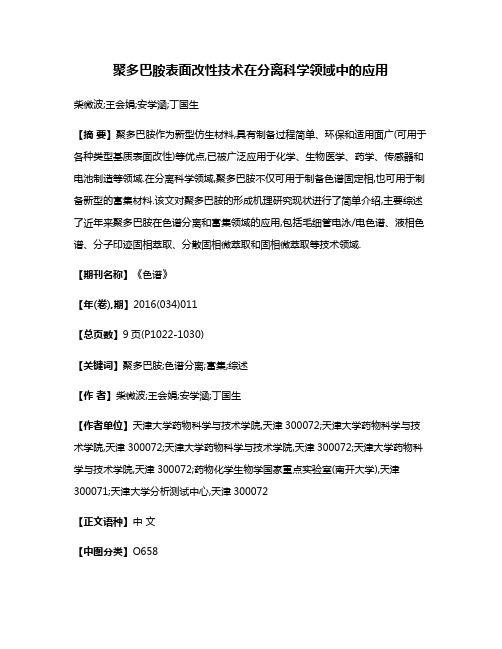
聚多巴胺表面改性技术在分离科学领域中的应用柴微波;王会娟;安学涵;丁国生【摘要】聚多巴胺作为新型仿生材料,具有制备过程简单、环保和适用面广(可用于各种类型基质表面改性)等优点,已被广泛应用于化学、生物医学、药学、传感器和电池制造等领域.在分离科学领域,聚多巴胺不仅可用于制备色谱固定相,也可用于制备新型的富集材料.该文对聚多巴胺的形成机理研究现状进行了简单介绍,主要综述了近年来聚多巴胺在色谱分离和富集领域的应用,包括毛细管电泳/电色谱、液相色谱、分子印迹固相萃取、分散固相微萃取和固相微萃取等技术领域.【期刊名称】《色谱》【年(卷),期】2016(034)011【总页数】9页(P1022-1030)【关键词】聚多巴胺;色谱分离;富集;综述【作者】柴微波;王会娟;安学涵;丁国生【作者单位】天津大学药物科学与技术学院,天津300072;天津大学药物科学与技术学院,天津300072;天津大学药物科学与技术学院,天津300072;天津大学药物科学与技术学院,天津300072;药物化学生物学国家重点实验室(南开大学),天津300071;天津大学分析测试中心,天津300072【正文语种】中文【中图分类】O658新型分离和富集材料的制备一直以来都是分离科学的研究重点,通过合理调控基体材料表面结构和组成,可以达到改善材料性能的目的。
目前,表面改性方法众多,但发展一种适用面广、操作简单且绿色环保的表面改性方法仍是极具挑战性的课题。
近些年来,海洋生物贻贝能够牢固地附着于各种基体材料表面的能力引起了人们的广泛关注。
研究表明,贻贝可分泌出特殊的黏附蛋白,而此蛋白中富含左旋多巴(3,4-二羟基-L-苯丙氨酸,L-DOPA)[1-3], L-DOPA是使黏附蛋白具有黏附特性的决定性因素,其结构中的邻苯二酚可氧化形成邻苯醌,进而促使其自身产生交联[4,5]。
基于仿生学原理,研究和开发合成方法简单、造价低廉、环境友好且性能稳定的黏合材料已成为相关领域的研究热点。
聚多巴胺表面修饰纳米二氧化硅对PP/POE复合材料性能的影响

合材料 ,并利用红外光谱分析 、力学性 能 、接触角 、DSC和扫描 电镜 (SEM)测 试分别研 究了复合材料 的结构 、力 学
性 能 、表界面性能 、结 晶性能 和断面形 貌。结果表面 ,PD—SiP 的加 入起 到 了明显的 刚性 粒子增 强效果 ,提高 了材料 的刚性和韧性 ,提高 了 PP/POE复合材 料的亲水性 ,降低 了 PP/POE复合材料 的结 晶温度 ,提 高了结 晶度 。
Abstract:The sur face modif ied particle (PD-SiP2) of surface modified nano silicon dioxide with
polydopamine was prepared by a simple way which made use of the character istic of the oxidative polymerization of dopamine on the Sur face of nano silicon dioxide. The infrared spectroscopy results showed that polydopamine adhered to the surface of nano silicon dioxide without dam aging the structure of nano silicon
dioxide. Furthermore, PD—SiO2 was mixed into the polypropylene/polyethylene—octene (PP/POE)
composites by melt blending to produce the high—per formance hydrophilic polypropylene composite. Besides, with the help of infrared spectroscopy, mechanical testing, contact angle testing, differential scanning calorimetry and scanning electron microscopy, we studied the stru cture, mechanical property, surface and interface property, crystallization property and fracture morphology of the composites. The results show that PD—SiO2 improves the rigidity, toughness and hydrophilic property of the PP/POE composites, reduces the crystallization temperature and enhances the cry stallinity.
聚多巴胺涂层的制备
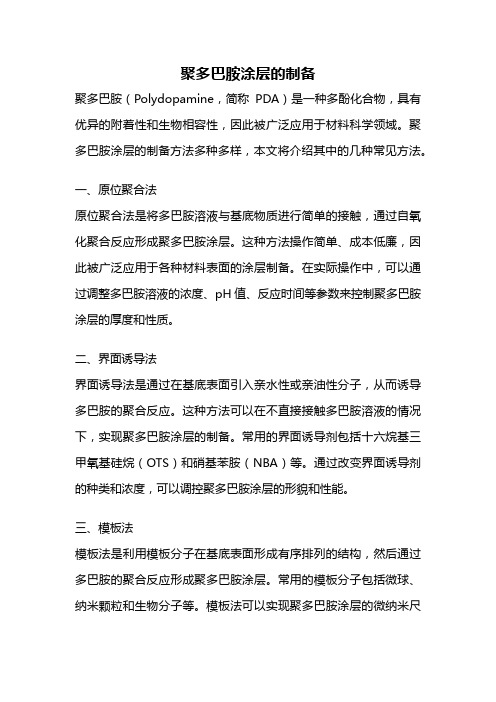
聚多巴胺涂层的制备聚多巴胺(Polydopamine,简称PDA)是一种多酚化合物,具有优异的附着性和生物相容性,因此被广泛应用于材料科学领域。
聚多巴胺涂层的制备方法多种多样,本文将介绍其中的几种常见方法。
一、原位聚合法原位聚合法是将多巴胺溶液与基底物质进行简单的接触,通过自氧化聚合反应形成聚多巴胺涂层。
这种方法操作简单、成本低廉,因此被广泛应用于各种材料表面的涂层制备。
在实际操作中,可以通过调整多巴胺溶液的浓度、pH值、反应时间等参数来控制聚多巴胺涂层的厚度和性质。
二、界面诱导法界面诱导法是通过在基底表面引入亲水性或亲油性分子,从而诱导多巴胺的聚合反应。
这种方法可以在不直接接触多巴胺溶液的情况下,实现聚多巴胺涂层的制备。
常用的界面诱导剂包括十六烷基三甲氧基硅烷(OTS)和硝基苯胺(NBA)等。
通过改变界面诱导剂的种类和浓度,可以调控聚多巴胺涂层的形貌和性能。
三、模板法模板法是利用模板分子在基底表面形成有序排列的结构,然后通过多巴胺的聚合反应形成聚多巴胺涂层。
常用的模板分子包括微球、纳米颗粒和生物分子等。
模板法可以实现聚多巴胺涂层的微纳米尺度的控制,因此在制备功能性涂层和纳米材料方面具有广泛应用前景。
四、电化学法电化学法是通过在电极表面施加电压或电流的方式,使多巴胺在电化学界面上发生聚合反应,从而形成聚多巴胺涂层。
这种方法可以实现对聚多巴胺涂层的厚度、形貌和结构的精确控制。
通过调节电化学反应的条件,例如电压、电流密度和电解液成分等,可以实现对聚多巴胺涂层性能的调控。
五、辅助剂法辅助剂法是在多巴胺溶液中加入一定比例的辅助剂,通过与多巴胺分子相互作用,改变其聚合行为,从而实现聚多巴胺涂层的制备。
常用的辅助剂包括酸碱、盐类和有机溶剂等。
辅助剂的选择和浓度可以对聚多巴胺涂层的形貌和性能产生显著影响,因此合理调控辅助剂的添加条件对于聚多巴胺涂层的制备十分重要。
聚多巴胺涂层的制备方法多种多样,各具特点。
选择合适的制备方法,可以实现对聚多巴胺涂层的形貌、性能和厚度的精确控制,为材料科学领域的研究和应用提供了广阔的空间。
聚多巴胺修饰固体材料表面研究进展_陈铭忆
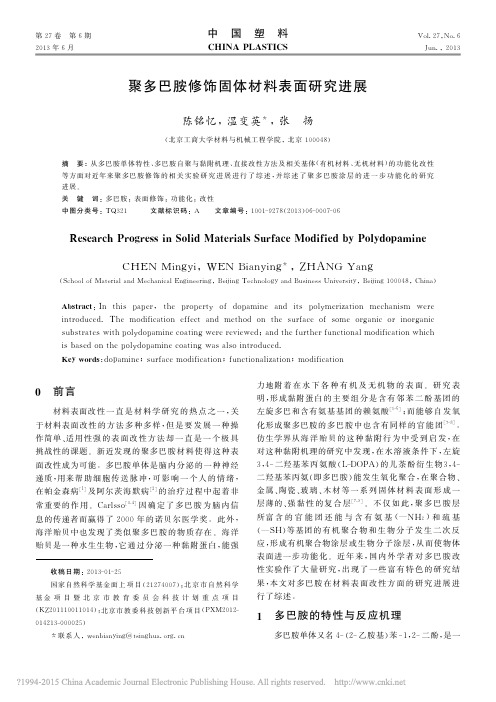
Vol.27,No.6 Jun.,2013
聚多巴胺修饰固体材料表面研究进展
陈铭忆,温变英* ,张 扬
(北京工商大学材料与机械工程学院,北京 100048)
摘 要:从多巴胺单体特性、多巴胺自聚与黏附机理、直接改性方法及相关基体(有机 材 料、无 机 材 料)的 功 能 化 改 性 等方面对近年来聚多巴 胺 修 饰 的 相 关 实 验 研 究 进 展 进 行 了 综 述 ,并 综 述 了 聚 多 巴 胺 涂 层 的 进 一 步 功 能 化 的 研 究 进展。 关 键 词 :多 巴 胺 ;表 面 修 饰 ;功 能 化 ;改 性 中 图 分 类 号 :TQ321 文 献 标 识 码 :A 文 章 编 号 :1001-9278(2013)06-0007-06
力地附 着 在 水 下 各 种 有 机 及 无 机 物 的 表 面。 研 究 表 明,形成黏附 蛋 白 的 主 要 组 分 是 含 有 邻 苯 二 酚 基 团 的 左旋多巴和含有氨 基 基 团 的 赖 氨 酸[5-6];而 能 够 自 发 氧 化形成聚多巴胺的 多 巴 胺 中 也 含 有 同 样 的 官 能 团 。 [7-8] 仿生学界从 海 洋 贻 贝 的 这 种 黏 附 行 为 中 受 到 启 发,在 对这种黏附机理的研究 中 发 现,在 水 溶 液 条 件 下,左 旋 3,4- 二羟基苯 丙 氨 酸 (L-DOPA)的 儿 茶 酚 衍 生 物3,4- 二羟基苯丙氨(即多巴胺)能 发 生 氧 化 聚 合,在 聚 合 物、 金属、陶瓷、玻 璃、木 材 等 一 系 列 固 体 材 料 表 面 形 成 一 层薄的、强 黏 性 的 复 合 层 。 [7-9] 不 仅 如 此,聚 多 巴 胺 层 所富 含 的 官 能 团 还 能 与 含 有 氨 基 (—NH2 )和 巯 基 (—SH)等基团 的 有 机 聚 合 物 和 生 物 分 子 发 生 二 次 反 应,形成有机聚合物涂层 或 生 物 分 子 涂 层,从 而 使 物 体 表面进一步 功 能 化。 近 年 来,国 内 外 学 者 对 多 巴 胺 改 性实验作了 大 量 研 究,出 现 了 一 些 富 有 特 色 的 研 究 结 果,本文对多 巴 胺 在 材 料 表 面 改 性 方 面 的 研 究 进 展 进 行了综述。
聚多巴胺-聚乙烯亚胺改性反渗透膜制备与表征

聚多巴胺-聚乙烯亚胺改性反渗透膜制备与表征谷金钰;李昊;许文盛;张平仓【摘要】饮用水短缺和水污染问题严重影响着人类和社会的发展.反渗透技术提供了一种高效经济的方法来生产纯水和处理废水,以缓解这个问题.但是,反渗透膜的污染尤其是生物污染严重制约着其高效应用.膜表面改性技术是提升膜抗污染性能的最常用手段,通过多巴胺盐酸盐(DA)在聚酰胺反渗透膜表面自聚,生成超薄聚多巴胺涂层(PDA),进一步利用PDA涂层上的活性基团将聚乙烯亚胺(PEI)接枝到反渗透膜表面,得到稳定持久的PDA-PEI改性反渗透膜.通过对改性膜的XPS测试,亲水性和抗菌性试验,得到以下结论:PDA成功涂层于反渗透膜表面,且PEI成功接枝于PDA 涂层表面;PDA-PEI改性增大了膜表面的亲水性,提升了反渗透膜抗污染的能力,使其具有了一定的抗菌能力.【期刊名称】《人民长江》【年(卷),期】2017(048)016【总页数】5页(P31-34,42)【关键词】反渗透膜;净水技术;表面改性;抗污染性;抗菌性【作者】谷金钰;李昊;许文盛;张平仓【作者单位】水利部科技推广中心,北京 100038;长江科学院水土保持研究所,湖北武汉 430010;长江科学院水土保持研究所,湖北武汉 430010;长江科学院水土保持研究所,湖北武汉 430010【正文语种】中文【中图分类】X52随着全球人口的快速增长和水污染的加剧,淡水资源短缺问题严重影响了人类健康、工业生产和农业灌溉等[1-2]。
我国水资源短缺已成为制约社会经济发展的一个重要因素[3-5]。
而自反渗透技术诞生以来,已经取得了蓬勃发展,在海水淡化、苦咸水脱盐、纯水/超纯水生产等方面显示出巨大优势,广泛应用于生物、医药、食品、化工等行业[6-7]。
但其在广泛应用的同时,也受到膜污染问题的困扰,反渗透膜的污染,尤其是生物污染,会造成反渗透膜通量和截留率下降,严重影响着反渗透膜的使用[8-10]。
为了解决这个问题,研究者们做了大量工作,其中对现有反渗透膜进行表面改性是目前研究的热点[11-13]。
聚多巴胺在生物材料表面改性中的应用

聚多巴胺在生物材料表面改性中的应用一、本文概述本文旨在探讨聚多巴胺(Polydopamine, PDA)在生物材料表面改性中的应用。
作为一种新兴的、具有生物活性的材料,聚多巴胺因其独特的性质,如良好的生物相容性、粘附性、以及易于功能化的特性,在生物医学工程、组织工程、药物传递、生物传感器等多个领域受到广泛关注。
本文将详细介绍聚多巴胺的合成方法、表面改性的原理及其在生物材料表面改性中的具体应用,并探讨其可能存在的问题和未来发展方向。
通过本文的阐述,希望能为相关领域的研究者提供有益的参考和启示,推动聚多巴胺在生物材料表面改性领域的进一步发展和应用。
二、聚多巴胺的合成与性质聚多巴胺(Polydopamine, PDA)是一种模拟海洋生物贻贝粘附蛋白的人工合成高分子材料,因其独特的粘附性和生物活性,在生物材料表面改性领域具有广泛的应用前景。
聚多巴胺的合成主要基于多巴胺(Dopamine)的氧化自聚合反应,这一过程可以在多种基材表面进行,包括金属、非金属、有机和无机材料等。
多巴胺是一种生物活性分子,广泛存在于生物体内,特别是哺乳动物的中枢神经系统中。
在碱性条件下,多巴胺可以发生氧化自聚合反应,生成聚多巴胺。
这种聚合反应过程相对简单,可以在水溶液中进行,且对温度要求不高,通常在室温下即可进行。
聚多巴胺具有一系列独特的性质,使其成为生物材料表面改性的理想选择。
聚多巴胺具有强大的粘附性,可以紧密地附着在各种材料表面,形成一层均匀的涂层。
聚多巴胺具有良好的生物相容性和生物活性,可以促进细胞粘附和增殖,有利于生物材料在生物体内的应用。
聚多巴胺还含有丰富的官能团,如羟基、氨基和醌基等,这些官能团可以进一步与其他生物分子或药物进行化学反应,实现生物材料的功能化。
聚多巴胺的合成相对简单,性质独特,具有良好的粘附性、生物相容性和生物活性,以及丰富的官能团,这些特点使得聚多巴胺在生物材料表面改性领域具有广阔的应用前景。
通过聚多巴胺的改性,可以改善生物材料的表面性能,提高其生物相容性和功能性,从而满足生物医学工程领域对生物材料日益增长的需求。
聚多巴胺表面与聚丙烯酸反应
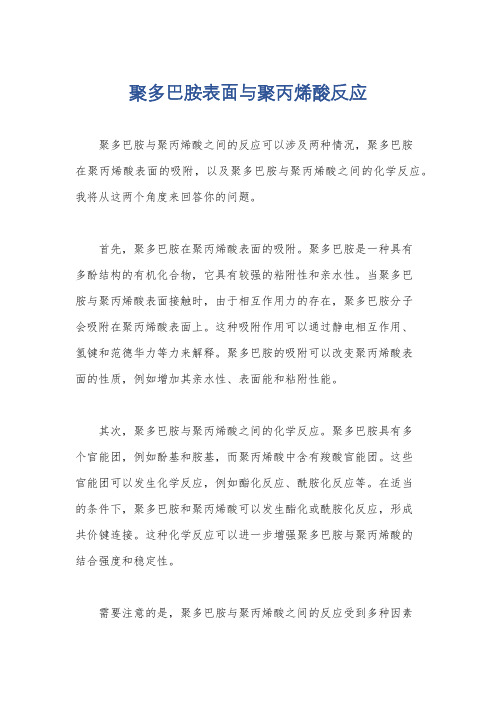
聚多巴胺表面与聚丙烯酸反应
聚多巴胺与聚丙烯酸之间的反应可以涉及两种情况,聚多巴胺
在聚丙烯酸表面的吸附,以及聚多巴胺与聚丙烯酸之间的化学反应。
我将从这两个角度来回答你的问题。
首先,聚多巴胺在聚丙烯酸表面的吸附。
聚多巴胺是一种具有
多酚结构的有机化合物,它具有较强的粘附性和亲水性。
当聚多巴
胺与聚丙烯酸表面接触时,由于相互作用力的存在,聚多巴胺分子
会吸附在聚丙烯酸表面上。
这种吸附作用可以通过静电相互作用、
氢键和范德华力等力来解释。
聚多巴胺的吸附可以改变聚丙烯酸表
面的性质,例如增加其亲水性、表面能和粘附性能。
其次,聚多巴胺与聚丙烯酸之间的化学反应。
聚多巴胺具有多
个官能团,例如酚基和胺基,而聚丙烯酸中含有羧酸官能团。
这些
官能团可以发生化学反应,例如酯化反应、酰胺化反应等。
在适当
的条件下,聚多巴胺和聚丙烯酸可以发生酯化或酰胺化反应,形成
共价键连接。
这种化学反应可以进一步增强聚多巴胺与聚丙烯酸的
结合强度和稳定性。
需要注意的是,聚多巴胺与聚丙烯酸之间的反应受到多种因素
的影响,如反应条件(温度、pH值等)、反应时间和表面处理等。
此外,具体的反应机理和产物结构可能会因实验条件的不同而有所变化。
综上所述,聚多巴胺与聚丙烯酸之间的反应可以涉及聚多巴胺在聚丙烯酸表面的吸附以及化学反应。
这种反应的发生可以改变聚丙烯酸表面的性质,并且在一定的条件下,聚多巴胺和聚丙烯酸可以形成共价键连接。
聚多巴胺降解产物
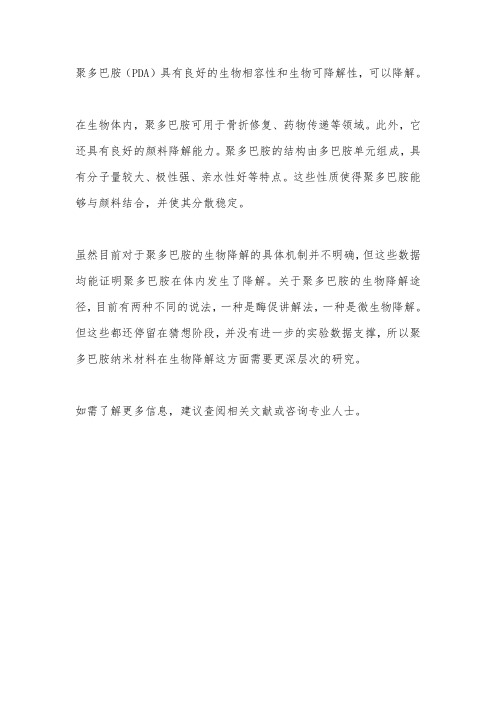
聚多巴胺(PDA)具有良好的生物相容性和生物可降解性,可以降解。
在生物体内,聚多巴胺可用于骨折修复、药物传递等领域。
此外,它还具有良好的颜料降解能力。
聚多巴胺的结构由多巴胺单元组成,具有分子量较大、极性强、亲水性好等特点。
这些性质使得聚多巴胺能够与颜料结合,并使其分散稳定。
虽然目前对于聚多巴胺的生物降解的具体机制并不明确,但这些数据均能证明聚多巴胺在体内发生了降解。
关于聚多巴胺的生物降解途径,目前有两种不同的说法,一种是酶促讲解法,一种是微生物降解。
但这些都还停留在猜想阶段,并没有进一步的实验数据支撑,所以聚多巴胺纳米材料在生物降解这方面需要更深层次的研究。
如需了解更多信息,建议查阅相关文献或咨询专业人士。
聚多巴胺红外特征吸收峰
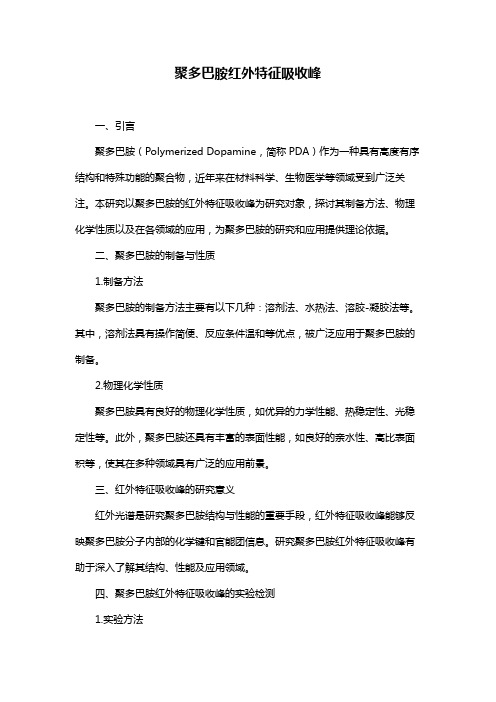
聚多巴胺红外特征吸收峰一、引言聚多巴胺(Polymerized Dopamine,简称PDA)作为一种具有高度有序结构和特殊功能的聚合物,近年来在材料科学、生物医学等领域受到广泛关注。
本研究以聚多巴胺的红外特征吸收峰为研究对象,探讨其制备方法、物理化学性质以及在各领域的应用,为聚多巴胺的研究和应用提供理论依据。
二、聚多巴胺的制备与性质1.制备方法聚多巴胺的制备方法主要有以下几种:溶剂法、水热法、溶胶-凝胶法等。
其中,溶剂法具有操作简便、反应条件温和等优点,被广泛应用于聚多巴胺的制备。
2.物理化学性质聚多巴胺具有良好的物理化学性质,如优异的力学性能、热稳定性、光稳定性等。
此外,聚多巴胺还具有丰富的表面性能,如良好的亲水性、高比表面积等,使其在多种领域具有广泛的应用前景。
三、红外特征吸收峰的研究意义红外光谱是研究聚多巴胺结构与性能的重要手段,红外特征吸收峰能够反映聚多巴胺分子内部的化学键和官能团信息。
研究聚多巴胺红外特征吸收峰有助于深入了解其结构、性能及应用领域。
四、聚多巴胺红外特征吸收峰的实验检测1.实验方法本研究采用红外光谱仪对聚多巴胺样品进行红外吸收光谱检测。
首先对聚多巴胺样品进行处理,使其具有良好的红外透射性能;然后将样品放入红外光谱仪,记录红外吸收光谱图。
2.实验结果与分析实验结果表明,聚多巴胺红外特征吸收峰位于1600 cm、1500 cm、1400 cm等波数附近。
通过对红外特征吸收峰的分析,可以初步判断聚多巴胺分子中存在的化学键和官能团。
五、聚多巴胺红外特征吸收峰的应用1.在材料科学中的应用聚多巴胺红外特征吸收峰的研究对于优化材料结构和性能具有重要意义。
通过改变聚多巴胺分子的组成和结构,可以调节红外特征吸收峰的位置和强度,从而实现对材料性能的调控。
2.在生物医学领域的应用聚多巴胺红外特征吸收峰的研究有助于发展生物医学诊断技术和药物筛选。
聚多巴胺作为一种生物相容性良好的材料,可用于生物医学领域的传感器、纳米载体等领域。
多巴胺及介孔材料对电子烟储油棉的改性
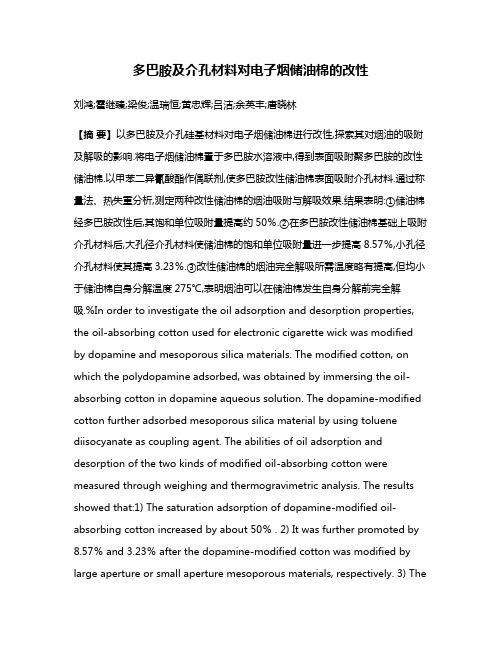
多巴胺及介孔材料对电子烟储油棉的改性刘鸿;霍继臻;梁俊;温瑞恒;黄忠辉;吕洁;余英丰;唐晓林【摘要】以多巴胺及介孔硅基材料对电子烟储油棉进行改性,探索其对烟油的吸附及解吸的影响.将电子烟储油棉置于多巴胺水溶液中,得到表面吸附聚多巴胺的改性储油棉.以甲苯二异氰酸酯作偶联剂,使多巴胺改性储油棉表面吸附介孔材料.通过称量法、热失重分析,测定两种改性储油棉的烟油吸附与解吸效果.结果表明:①储油棉经多巴胺改性后,其饱和单位吸附量提高约50%.②在多巴胺改性储油棉基础上吸附介孔材料后,大孔径介孔材料使储油棉的饱和单位吸附量进一步提高8.57%,小孔径介孔材料使其提高3.23%.③改性储油棉的烟油完全解吸所需温度略有提高,但均小于储油棉自身分解温度275℃,表明烟油可以在储油棉发生自身分解前完全解吸.%In order to investigate the oil adsorption and desorption properties, the oil-absorbing cotton used for electronic cigarette wick was modified by dopamine and mesoporous silica materials. The modified cotton, on which the polydopamine adsorbed, was obtained by immersing the oil-absorbing cotton in dopamine aqueous solution. The dopamine-modified cotton further adsorbed mesoporous silica material by using toluene diisocyanate as coupling agent. The abilities of oil adsorption and desorption of the two kinds of modified oil-absorbing cotton were measured through weighing and thermogravimetric analysis. The results showed that:1) The saturation adsorption of dopamine-modified oil-absorbing cotton increased by about 50% . 2) It was further promoted by 8.57% and 3.23% after the dopamine-modified cotton was modified by large aperture or small aperture mesoporous materials, respectively. 3) Thecomplete desorption temperatures of the modified oil-absorbing cotton rose a little, but were still under the decomposition temperature of oil-absorbing cotton, 275 ℃. It indicated that the desorptive release of electronic liquids was complete before the decomposition of oil-absorbing cotton.【期刊名称】《烟草科技》【年(卷),期】2017(050)008【总页数】7页(P68-74)【关键词】电子烟;储油棉;多巴胺;介孔硅基材料;吸附;解吸【作者】刘鸿;霍继臻;梁俊;温瑞恒;黄忠辉;吕洁;余英丰;唐晓林【作者单位】广西中烟工业有限责任公司,南宁市北湖南路28号 530001;复旦大学高分子科学系聚合物分子工程国家重点实验室,上海市杨浦区邯郸路220号200433;广西中烟工业有限责任公司,南宁市北湖南路28号 530001;复旦大学高分子科学系聚合物分子工程国家重点实验室,上海市杨浦区邯郸路220号 200433;广西中烟工业有限责任公司,南宁市北湖南路28号 530001;复旦大学高分子科学系聚合物分子工程国家重点实验室,上海市杨浦区邯郸路220号 200433;复旦大学高分子科学系聚合物分子工程国家重点实验室,上海市杨浦区邯郸路220号 200433;复旦大学高分子科学系聚合物分子工程国家重点实验室,上海市杨浦区邯郸路220号 200433;复旦大学化学系,上海市杨浦区邯郸路220号 200433【正文语种】中文【中图分类】TS45电子烟是一种将电子烟液经雾化器雾化向呼吸系统传送烟碱及其他物质的产品[1]。
- 1、下载文档前请自行甄别文档内容的完整性,平台不提供额外的编辑、内容补充、找答案等附加服务。
- 2、"仅部分预览"的文档,不可在线预览部分如存在完整性等问题,可反馈申请退款(可完整预览的文档不适用该条件!)。
- 3、如文档侵犯您的权益,请联系客服反馈,我们会尽快为您处理(人工客服工作时间:9:00-18:30)。
2015/10/52012-10-12
2015/10/52012-10-12
2015/10/52012-10-12
Results
S的利用率提高
typical discharge potential plateau at about 2.30 V and 2.0 V (vs Li/Li+) can be easily observed in the initial cycle for the two comparative cells, assigned to the reduction from sulfur to lithium polysulfides and further reduction to Li2S2/Li2S and in consistent with the CVs. For the cell using PDA modified separator, obvious decreasing of discharge capacity can be observed in the second cycle, which may relate to the dissolution of polysulfide and will be further disscussed in the below
2015/10/52012-10-12
Results
It can be seen that only the peak of C1s can be observed, while for the PDA modified seperator, two additional peaks attributed to N1s and O1s appear at 400.4 and 532.7 eV, respectively, indicating that PDA coating layer is generated on the surface of seperator to produce a hydrophilic seperator
2015/10/52012-10-12
Experimental
• • • • S:AB=6:4 300r/h球磨 2h put it into a PTFE container filled with argon container was heated at 155 °C for 12 h cooled down to room temperature
2015/10/52012-10-12
Results
However, for the cell using bare separator, two cathodic peak appear at about 2.25 and 1.80 V (vs Li/Li+) (Fig. 6b), which are slightly lower than the aforementioned results. In addition, two overlapped anodic peak potentials in the voltage range of 2.6-2.7 V can be observed, suggesting a twoplateauoxidation process occurred in the anodic scan, which is different with the only one broad anodic peak potential at 2.60 V for the cell using PDA modified separator.
2015/10/52012-10-12
Two
Results
high-rate charge/discharge capability cycling stability a higher coulombic efficiency
2015/10/52012-10-12
Results
It is obvious that the cell using the PDA modified seperator can obvious decrease the charge-transfer resistance of the sulfur cathodes as compared to bare separator, especially in the second discharge state. polysulfide will dissolved into the electrolyte and more and more Li2S2/Li2S will be deposited on the cathodes, leading to the loss of active materials and fast dropping of capacity.
S/AB composite
• • • •
S/C composite :acetylene black:PTFE=7:2:1with ethanol as a dispersant compressed into a thin piec cut into a disk film of 8mm in diameter and 1.5~1.8 mg in weight dried in the oven at 55 °C for 12 h
2015/10/52012-10-12
Conclusion
• PDA modified hydrophilic separators are prepared by a simple dipping method • Due to the PDA moБайду номын сангаасification, the surface character of the polyolefin-based separators changes from hydrophobicity to hydrophily, thus resulting in the improvement of uptake amounts of liquid electrolytes and ionic conductivity, • Accompanying with remarkably enhancement of charge/discharge capacities, cycling performance, and high-rate capability • At 0.2 C rate, the initial discharge capacity of the cell using hydrophilic separator is 1217 mAh/g , and it can be stably retained at 1020.3 mAh /g, showing obvious advantages over the conventional hydrophobic separator. • At the 1 C rate, a high reversible capacity of 548.3 mAh/g can also be obtained, while it gets only about 373.5 mAh/g for the cell using hydrophobic separator.
sulfur cathode
2015/10/52012-10-12
The surface modification of separators
separators were soaked into 50 ml methanol solution (30 minutes) put into the dopamine solution(24h) rinsed with distilled water for several times dried at 30 °C for 12 h.
文献汇报
2015.4.18
2015/10/52012-10-12
2015/10/52012-10-12
Disadvantage hydrophobic surface, which seriously hinder the adequate uptake and diffusion of organic electrolytes within the separators. Moreover, it is difficult to completely ensure the electrical isolation between the cathode and anode due to their poor thermal shrinkage, leading to low capacity, poor power capability and security risks upon cycling. Polydopamine Polydopamine, with a molecular structure that incorporates many functional groups such as catechol, amine and imine, can be easily deposited on all types of inorganic and organic substrates, even super-hydrophobic surfaces.
2015/10/52012-10-12
Results
• wetting test
after dropping an organic electrolyte [1 wt% LiNO3 and 1.0 M 30 LiN(CF3SO2)2 dissolved in DOL/TEGDME, v/v= 1:1)] onto the surface of the separator, the droplet can hardly wet the bare separator (left), whereas the PDA modified separato (right) is fully wetted immediately.
